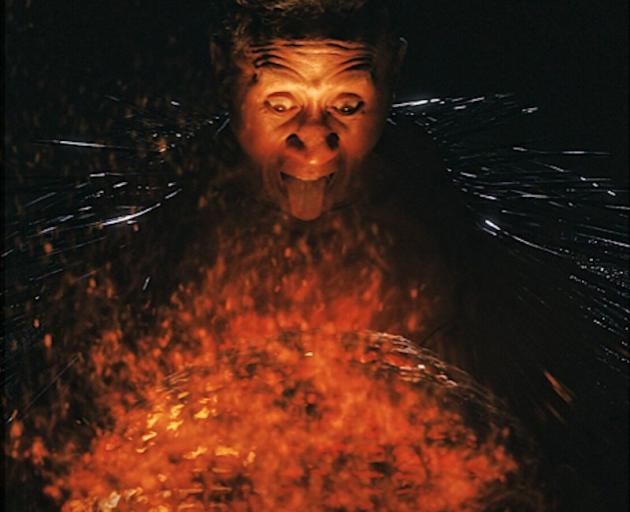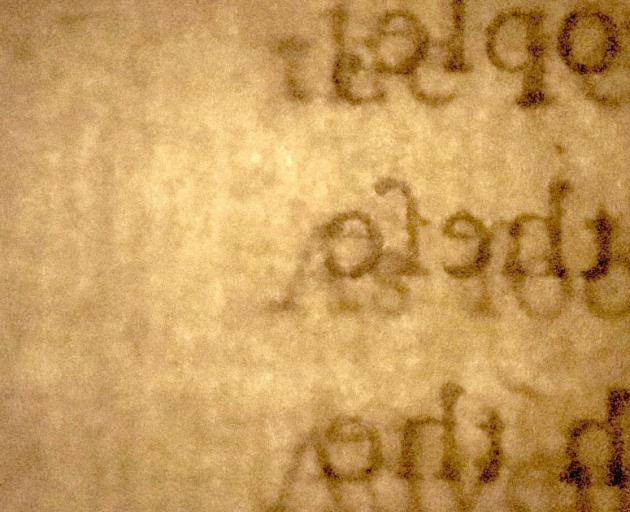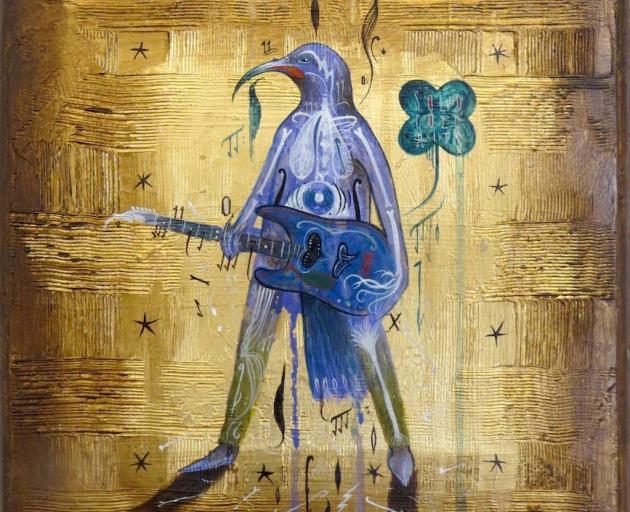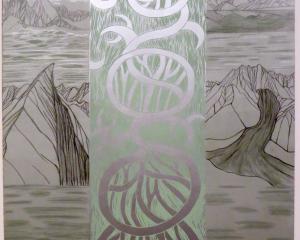BY JAMES DIGNAN

(Milford Gallery)
Lisa Reihana has continued her exploration and re-evaluation of Maori myth with her exhibition "Ihi — Mother and Son". The works on display are a series of images in crystal flex on aluminium, all of them stills from a major video installation by the artist.
In the images, Reihana has re-examined the Maori creation myth of Ranginui and Papatuanuku, focusing her attention on the relationship between Papatuanuku and her offspring, especially her son Tane. In doing this, the centre of attention is removed from the initial consummation of Rangi and Papa’s love and is redirected to the birth of the sacred daily cycle of Te Ao and Te Po, light and darkness.
Reihana has been blessed to work with two fine actor/dancers, Taane Mete and Nancy Wijohn, in the creation of these works. The sheer power and dynamism of their balletic movements is captured well in Reihana’s images, images which resonate with the strength of the epic tale being re-created. The force emanating from the story is magnified by the deliberate use of underexposure and sombre black backgrounds; strong side-lighting makes images such as "Pounamu" and "Kahurangi" appear as much studies of line and form as they are scenes from legend.

(Blue Oyster Art Project Space)
Blue Oyster’s latest installation is an intriguing elegaic reflection on early European exploration in the Pacific and the use of the written word to provide descriptions of the explorers’ "discoveries".
Peter Simpson uses as his subject the text of Georg Forster’s seminal book A Voyage Round the World in His Britannic Majesty’s Sloop, Resolution. The work was published weeks before the official account of the expedition by ship’s captain James Cook, but differed from it in a substantial way by being more of a travelogue in the modern sense than simply a dry recounting of facts, making it a near unique document for its time. Simpson reframes this document of European arrival by literally dissecting and preserving the text as if it were a museum exhibit.
Fragments of text have been presented as photographic slides, allowing us to see the textures of the paper on which the text is printed — a literal "subtext". Elsewhere, in a wry twist, pages have become messages in bottles — bottles of "Endeavour" brand soda water — crated up for export.
In forcing the original work to be placed under close physical and metaphorical scrutiny, as an artefact as much as simply words, we get a chance to reconsider the text and its importance in the growth of science, literature, and research in Aotearoa.

(Pea Sea Art)
Dean Raybould presents a wryly humorous yet thought-provoking exhibition which examines the Kiwi condition. Using kiwiana, music, and native birdlife as his main motifs, the artist presents us with a skewed yet truthful look at the utopia/dystopia which is New Zealand.
The works, in vivid colours and caricature-like style, owe a strong debt to the paintings of New Zealand master Bill Hammond (and therefore indirectly Walter Buller), but add intriguing wordplay and sculptural elements.
Environmentalism and the commercial exploitation of the land are major threads to many of the images, most notably in paintings such as Leg of Land. The works are frequently presented cut to shape, rather than on rectangular canvases, adding to their slightly cartoony feel, but also strengthening their impact. The centrepiece work, the cruciform Requiem for a Scene is particularly strong, with its Mitre Peak-inspired theme of the selling-off of the country’s (and by extension, the world’s) natural resources to the highest bidder.
A series of smaller works and works using musical instruments and instrument cases as their canvases also intrigues. Several of these pieces use images of cult musicians and indirectly compare human-created music and the natural calls of birdsong — the sound of (in the words of one piece) "native birds/bards".







![Untitled (c. mid 1990s, [pink 3]), by Martin Thompson, 415mm×590mm. Photo: courtesy of Brett...](https://www.odt.co.nz/sites/default/files/styles/odt_landscape_small_related_stories/public/story/2024/02/untitled_pink_3.jpg?itok=Q0aQrc9o)




